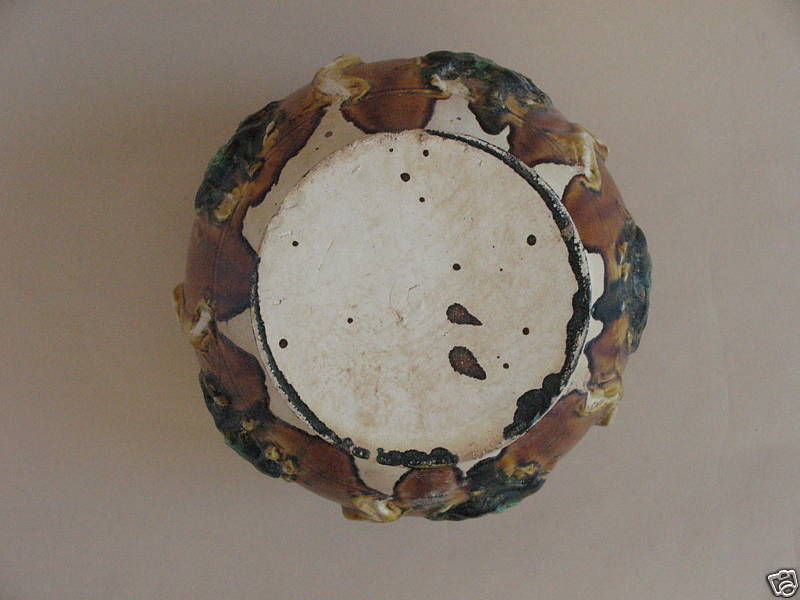
A Tang Dynasty Tri-color (Tricolor, Three-color) Glazed Pottery Pot with molded Applique
唐朝(A.D.1573-1619) 三彩貼花陶罐
Dimension of the pot is about 23 cm (largest diameter in the middle) x 25 cm (height).
Tang Tri-color Pottery (táng sān cǎi 唐三彩), also called Tang Sancai, is a kind of handmade glazed ware of exquisite craftsmanship created in the Northern and Southern Dynasty (nán běi cháo 南北朝, 386-589) about 1,400 years ago. During the Tang Dynasty (táng cháo 唐朝, 618-907), the production of Tang San Cai reached its peak, which is part of the reason the pottery got the name of Tang San Cai. It well reflects the high standards of ceramic art as well as the magnificent and luxurious lifestyle of Tang Dynasty society. It is known for its vivid design, flamboyant color and luster, and rich life ambiance. Luoyang (luò yáng 洛陽), named the eastern capital in ancient times, in Henan Province was the home of Tang San Cai, and most of unearthed Tang San Cai was found in Luoyang.
Tang Tri-color Pottery Tang San Cai is a polychrome handicraft with yellow, green, and white as its major tones. It is fired with lead glaze and presents a harmonious complex of varied colors, deep and light. The process is complicated: first, bake the ready mode in kilns until the temperature reaches 1,100oC, then take it out and apply glaze on it; bake it again in kilns at a temperature of about 900°C.
Tang San Cai items that have been unearthed include horses, humans, and even pillows, and camels, of which the pottery camel is one of the best. Its head rises high, as if telling stories about merchant caravans along the Silk Road in the remote past and the prosperity of the Tang Dynasty.
Tang Tricolor Pottery Being the gem of ancient Chinese art, Tang San Cai absorbed the advantages of Chinese painting, sculpture and stone carving. It features fleshy figures, regular and exquisite technics, compact carving traces, and smooth lines, indicating the high-level of the craft reached in the Tang Dynasty. Tang San Cai is mainly divided into pottery tomb-figures and daily commodities.
唐三彩
唐三彩是一種盛行于唐代的陶器,以黃、白、綠為基本釉色,後來人們習慣地把這類陶器稱為“唐三彩”。唐代是中國封建社會的鼎盛時期,經濟上繁榮興盛,文化藝術上群芳爭豔,唐三彩就是這一時期產生的一種彩陶工藝品,它以造型生動逼真、色澤豔麗和富有生活氣息而著稱。唐三彩的誕生已有1300多年的歷史了,它吸取了中國國畫、雕塑等工藝美術的特點,採用堆貼、刻畫等形式的裝飾圖案,線條粗獷有力。
唐三彩是一種低溫釉陶器,在色釉中加入不同的金屬氧化物,經過焙燒,便形成淺黃、赭黃、淺綠、深綠、天藍、褐紅、茄紫等多種色彩,但多以黃、褐、綠三色為主。它主要是陶坯上塗上的彩釉,在烘制過程中發生化學變化,色釉濃淡變化、互相浸潤、斑駁淋漓、色彩自然協調,花紋流暢,是一種具有中國獨特風格的傳統工藝品。唐三彩在色彩的相互輝映中,顯出堂皇富麗的藝術魅力。唐三彩用於隨葬,做為明器,因為它的胎質鬆脆,防水性能差,實用性遠不如當時已經出現的青瓷和白瓷。唐三彩分佈在長安和洛陽兩地,在長安的稱西窯,在洛陽的則稱東窯。唐代盛行厚葬,不僅是大官貴族,百姓也如此,已形成一股風氣。
唐三彩種類很多人物、動物、碗盤、水器、酒器、文具、傢俱、房屋,甚至裝骨灰的壺壇等等。大致上較為人喜愛的是馬俑,有的揚足飛奔,有的徘徊佇立,有的引頸嘶鳴,均表現出栩栩如生的各種姿態。最具代表性的是三彩胡人牽駱駝俑,現藏故宮博物院。至於人物造型有婦女、文官、武將、胡俑、天王,根據人物的社會地位和等級,刻畫出不同的性格和特徵;貴婦面部豐圓,梳成各式髮髻,穿著色彩鮮豔的服裝,文官彬彬有禮,武士剛烈勇猛,胡俑高鼻深目、天王怒目威武、雄壯氣概。